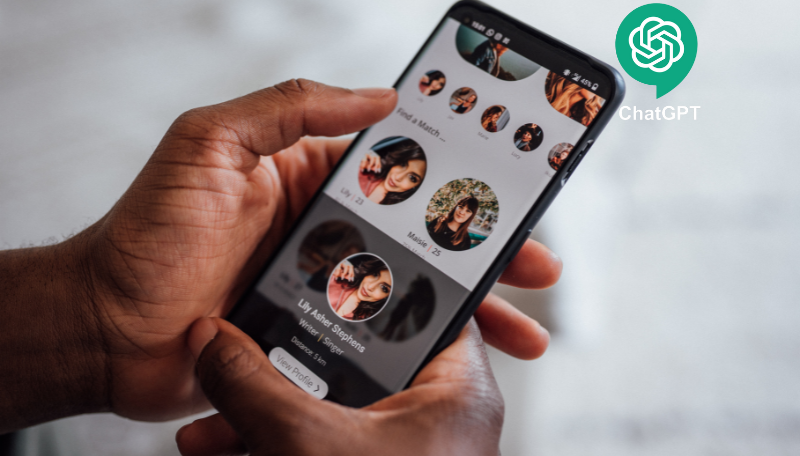Are You Sure You’re Not Chatting with ChatGPT on Tinder?
Since its inception, ChatGPT has had a dramatic impact on many digital landscapes, including dating apps.
Platforms like Tinder, once purely the domain of human interaction, are now seeing a shift with the integration of artificial intelligence.
But what if that shift is bad and breaks our trust in Tinder in general? What if we are still determining whether we are chatting with ChatGPT or a real human?
I believe this idea is disturbing to many people, including me. Despite how fun it may initially sound, this is still true.
I had this idea and wrote this article to explore the topic further. I would like to know if I could tell the difference between users chatting with a ChatGPT or humans.
This is what I’ve discovered in my research on the topic.
Red-Flag signals that you are chatting with ChatGPT and not a human
Interacting with someone online can be tricky, especially on platforms like Tinder. It can be hard to tell if the person is a human or an AI tool, such as ChatGPT.
https://www.youtube.com/watch?v=gq11F7U7Zuw
However, some tell-tale signs might indicate you're talking to a bot:
Red Flag 1 Immediate Responses
An AI like ChatGPT can generate responses instantly, much quicker than a human typically would. This is because they don't need time to read, process, and type out a response as humans do. However, some platforms might introduce artificial delays in bot responses to make them seem more human.
https://www.youtube.com/watch?v=E1baw6D2PqM&t=30s
Red Flag 2 Consistently Perfect Grammar and Spelling
While many humans have excellent spelling and grammar, they occasionally make mistakes. ChatGPT usually produces text that is grammatically correct and free of spelling mistakes. However, it can sometimes generate strange or nonsensical sentences.
Red Flag 3 Lack of Personal Information or Details
Chatbots are generally programmed not to share personal information. It could be a bot if your match avoids answering personal questions or their responses seem vague or generic. ChatGPT can generate contextually relevant responses but does not understand the content like a human does. This is because ChatGPT needs more true understanding.
Red Flag 4 Repetition or Non-Sequiturs
Sometimes, a bot may repeat certain phrases or give responses that don't fit the context of the conversation. This is because AIs, even sophisticated ones like ChatGPT, can sometimes need clarification on the context or nuances of a conversation.
Red Flag 5 Avoiding Direct Questions or Responses
AI systems could be better; sometimes, complex questions or prompts might result in an evasive or nonspecific response. ChatGPT can generate contextually relevant responses. However, it needs to understand the content it produces as a human does.
Quick Note: Remember that while these signals can help identify a potential bot, they could be more foolproof. As AI technology advances, these distinctions may become less apparent. It is important to remember that the presence of certain traits does not necessarily mean you are communicating with a bot. There may be other explanations.
How can you be sure that you are chatting with ChatGPT on Tinder
While the signals above can indicate interacting with an AI like ChatGPT, determining with absolute certainty if you're conversing with a bot or a human on platforms like Tinder can be complex.
As AI technology advances, human and AI communication distinctions become increasingly blurred. Moreover, some human behaviors, such as quick responses or a preference for maintaining privacy, can mimic those of a chatbot.
AI capabilities are constantly improving. Tinder matches should be aware of the potential for AI interaction. They should also maintain a healthy skepticism when necessary.
ChatGPT has revolutionized the way people communicate on Tinder. It has an advanced understanding of language nuances and can generate contextually relevant responses.
AI capabilities are constantly improving. Users should be aware of the potential for AI interaction. They should also maintain a healthy skepticism when necessary.
Bonus read: 5 unexpected ways to use ChatGPT in your Tinder convos and get a date
What to do when you know you are talking to ChatGPT and not your match on Tinder?
It is wise to avoid sharing sensitive personal information online. This is especially true when dealing with an entity that may not be human. Do not let your suspicions get in the way of this.
Both men and women should follow these suggestions:
Be Aware
Acknowledge the potential presence of AI in such platforms. Understanding that not all profiles are managed by actual people can help adjust expectations and prevent unwarranted emotional investment.
Avoid Sharing Personal Information
It is wise to avoid sharing sensitive personal information online. This is especially true when dealing with an entity that may not be human. Do not let your suspicions get in the way of this. This is crucial for maintaining privacy and security.
Report the Profile
If you're confident you're interacting with a bot, report the profile to the platform administrators.
They have the tools to verify and deal with such cases, which can help maintain the platform's integrity for other users.
Engage Wisely
If you choose to continue the conversation, use it as an opportunity to learn more about AI technology. However, remember that AI does not have emotions, personal experiences, or a deep understanding of the world and thus should not be treated as a potential romantic or emotional connection.
Stay Informed
Keep up-to-date with the latest advancements in AI technology, which can help you recognize AI interactions in the future. Remember, technology is rapidly advancing and becoming more sophisticated, making it increasingly challenging to distinguish between human and AI interactions.
Fun read: How to use ChatGPT for Tinder chat-up lines?
Wrapping up
Now you know numerous red-flag signals can indicate whether you are chatting with a ChatGPT and not the person you matched with. As mentioned above, chatbots cannot engage in deeply personal and unique discussions as humans, so I leave you to judge whether you are chatting with a human or a chatbot.
Hopefully, this article clarified some things about recognizing whether you are chatting with ChatgGPT or a real human.
Remember that even though ChatGPT is smart, you can be even smarter.

